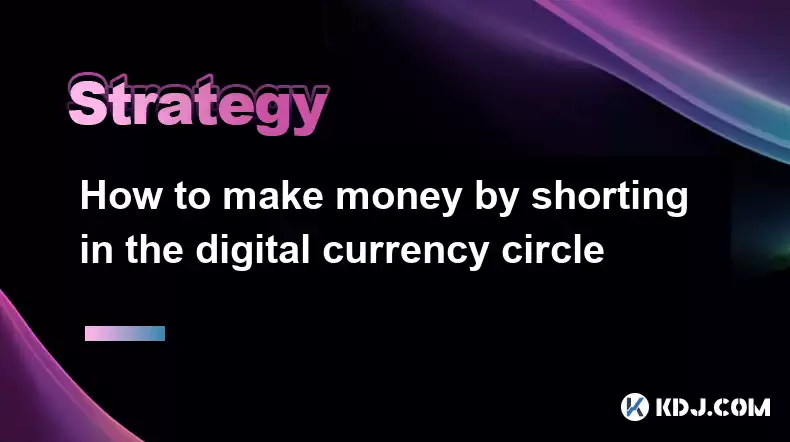-
 bitcoin
bitcoin $122659.385674 USD
0.52% -
 ethereum
ethereum $4484.113342 USD
-0.09% -
 bnb
bnb $1304.229256 USD
-0.85% -
 tether
tether $1.000204 USD
-0.03% -
 xrp
xrp $2.860636 USD
-0.51% -
 solana
solana $227.288799 USD
2.36% -
 usd-coin
usd-coin $0.999805 USD
0.01% -
 dogecoin
dogecoin $0.252837 USD
1.18% -
 tron
tron $0.341149 USD
1.12% -
 cardano
cardano $0.830507 USD
0.33% -
 hyperliquid
hyperliquid $45.792319 USD
0.04% -
 chainlink
chainlink $22.422164 USD
1.55% -
 ethena-usde
ethena-usde $1.000283 USD
0.01% -
 sui
sui $3.511389 USD
0.83% -
 stellar
stellar $0.385276 USD
-0.44%
How to make money by shorting in the digital currency circle
Shorting in the cryptocurrency market involves betting on the decline of an asset's price, identifying suitable opportunities through analysis, executing trades using various methods, managing risks effectively, and continuously monitoring and adjusting positions.
Jan 08, 2025 at 10:50 am

- Understand the basics of shorting in the cryptocurrency market.
- Identify suitable trading opportunities for shorting.
- Execute short trades using various methods.
- Manage risks effectively through stop-loss orders and position sizing.
- Monitor and adjust positions regularly based on market conditions.
Shorting is a trading strategy where traders bet on the price of an asset to decline. In the digital currency market, shorting involves borrowing a certain amount of a cryptocurrency, selling it at the current price, and agreeing to buy it back at a later date. If the price of the cryptocurrency falls during this period, the trader can buy it back at a lower price and return it to the lender, pocketing the difference as profit.
2. Identifying Shorting OpportunitiesIdentifying suitable trading opportunities for shorting requires a thorough analysis of market conditions. Traders should look for assets that exhibit bearish trends or technical indicators suggesting a potential decline. This analysis may include:
- Chart patterns indicating downward trends (e.g., descending triangles, head and shoulders).
- Technical indicators like overbought conditions (e.g., RSI, Bollinger Bands).
- Fundamental factors such as negative news or regulatory concerns.
There are three main ways to execute a short trade in the digital currency market:
- Margin trading: Borrow from a cryptocurrency exchange and sell the borrowed crypto.
- Futures contracts: Sell futures contracts that give you the right to sell an asset at a specified price at a future date.
- Options trading: Buy put options that give you the option to sell an asset at a specified price within a certain timeframe.
Shorting can be a risky trading strategy, especially in the volatile cryptocurrency market. It is essential to implement risk management techniques to minimize potential losses:
- Stop-loss orders: Set a predefined price at which your position will be automatically closed to prevent excessive losses.
- Position sizing: Limit the amount of capital you risk on each trade and ensure that your overall portfolio is well-diversified.
Once you have entered a short trade, it is crucial to monitor the market conditions and make adjustments as necessary. This may involve:
- Tracking the price movements of the target cryptocurrency.
- Analyzing market news and developments that may affect the asset's price.
- Adjusting your stop-loss orders or position size based on market volatility or changes in your risk tolerance.
The best cryptocurrency to short depends on market conditions and your trading strategy. However, popular cryptocurrencies that have experienced bearish trends in the past include Bitcoin (BTC), Ethereum (ETH), Ripple (XRP), Litecoin (LTC), and Cardano (ADA).
2. How much money can you make shorting cryptocurrency?The potential profit from shorting cryptocurrency is uncapped and depends on the price movement of the target asset. However, traders should be aware of potential losses as well.
3. Is it risky to short cryptocurrency?Yes, shorting cryptocurrency is inherently risky due to the volatility of the market. Traders should be prepared for potential losses and implement risk management techniques accordingly.
4. What is the difference between shorting and margin trading?Shorting and margin trading are both trading strategies that allow traders to profit from the decline in asset prices. However, margin trading involves borrowing funds from a broker or exchange to increase the size of your trades, while shorting involves borrowing a specific amount of an asset and selling it.
5. Can you make money shorting cryptocurrency without actually borrowing it?Yes, you can make money shorting cryptocurrency without actually borrowing it by using options trading. With options, you buy put options that give you the right to sell an asset at a specified price within a certain timeframe. If the price of the asset declines, you can exercise your option and sell it for a profit.
Disclaimer:info@kdj.com
The information provided is not trading advice. kdj.com does not assume any responsibility for any investments made based on the information provided in this article. Cryptocurrencies are highly volatile and it is highly recommended that you invest with caution after thorough research!
If you believe that the content used on this website infringes your copyright, please contact us immediately (info@kdj.com) and we will delete it promptly.
- BlockDAG, DOGE, HYPE Sponsorship: Crypto Trends Shaping 2025
- 2025-10-01 00:25:13
- Deutsche Börse and Circle: A StableCoin Adoption Powerhouse in Europe
- 2025-10-01 00:25:13
- BlockDAG's Presale Buzz: Is It the Crypto to Watch in October 2025?
- 2025-10-01 00:30:13
- Bitcoin, Crypto, and IQ: When Genius Meets Digital Gold?
- 2025-10-01 00:30:13
- Stablecoins, American Innovation, and Wallet Tokens: The Next Frontier
- 2025-10-01 00:35:12
- NBU, Coins, and Crypto in Ukraine: A New Yorker's Take
- 2025-10-01 00:45:14
Related knowledge

Practical parameter settings for a Bitcoin multi-timeframe moving average system
Sep 18,2025 at 10:54pm
Optimizing Timeframe Combinations for Bitcoin Trading1. Selecting appropriate timeframes is crucial when building a multi-timeframe moving average sys...

How can I filter out false breakouts in Dogecoin high-frequency trading?
Sep 22,2025 at 01:00am
Understanding False Breakouts in Dogecoin Trading1. A false breakout occurs when Dogecoin's price appears to move beyond a defined support or resistan...

Techniques for identifying tops and bottoms in the Bitcoin on-chain NVT model
Sep 20,2025 at 07:54pm
Understanding the NVT Model in Bitcoin Analysis1. The Network Value to Transactions (NVT) ratio is often described as the 'P/E ratio' of the cryptocur...

What does the surge in open interest in Bitcoincoin futures mean?
Sep 20,2025 at 11:18pm
Understanding the Surge in Dogecoin Futures Open Interest1. A surge in open interest within Dogecoin futures indicates a growing number of active cont...

How can I use the Ethereum USDT premium to gauge market sentiment?
Sep 18,2025 at 11:55pm
Understanding the Ethereum USDT Premium1. The Ethereum USDT premium refers to the price difference between USDT (Tether) traded on Ethereum-based plat...

What should I do if Ethereum staking yields decline?
Sep 20,2025 at 06:18am
Understanding the Causes Behind Declining Ethereum Staking Yields1. The Ethereum network transitioned to a proof-of-stake consensus mechanism with the...

Practical parameter settings for a Bitcoin multi-timeframe moving average system
Sep 18,2025 at 10:54pm
Optimizing Timeframe Combinations for Bitcoin Trading1. Selecting appropriate timeframes is crucial when building a multi-timeframe moving average sys...

How can I filter out false breakouts in Dogecoin high-frequency trading?
Sep 22,2025 at 01:00am
Understanding False Breakouts in Dogecoin Trading1. A false breakout occurs when Dogecoin's price appears to move beyond a defined support or resistan...

Techniques for identifying tops and bottoms in the Bitcoin on-chain NVT model
Sep 20,2025 at 07:54pm
Understanding the NVT Model in Bitcoin Analysis1. The Network Value to Transactions (NVT) ratio is often described as the 'P/E ratio' of the cryptocur...

What does the surge in open interest in Bitcoincoin futures mean?
Sep 20,2025 at 11:18pm
Understanding the Surge in Dogecoin Futures Open Interest1. A surge in open interest within Dogecoin futures indicates a growing number of active cont...

How can I use the Ethereum USDT premium to gauge market sentiment?
Sep 18,2025 at 11:55pm
Understanding the Ethereum USDT Premium1. The Ethereum USDT premium refers to the price difference between USDT (Tether) traded on Ethereum-based plat...

What should I do if Ethereum staking yields decline?
Sep 20,2025 at 06:18am
Understanding the Causes Behind Declining Ethereum Staking Yields1. The Ethereum network transitioned to a proof-of-stake consensus mechanism with the...
See all articles










































































